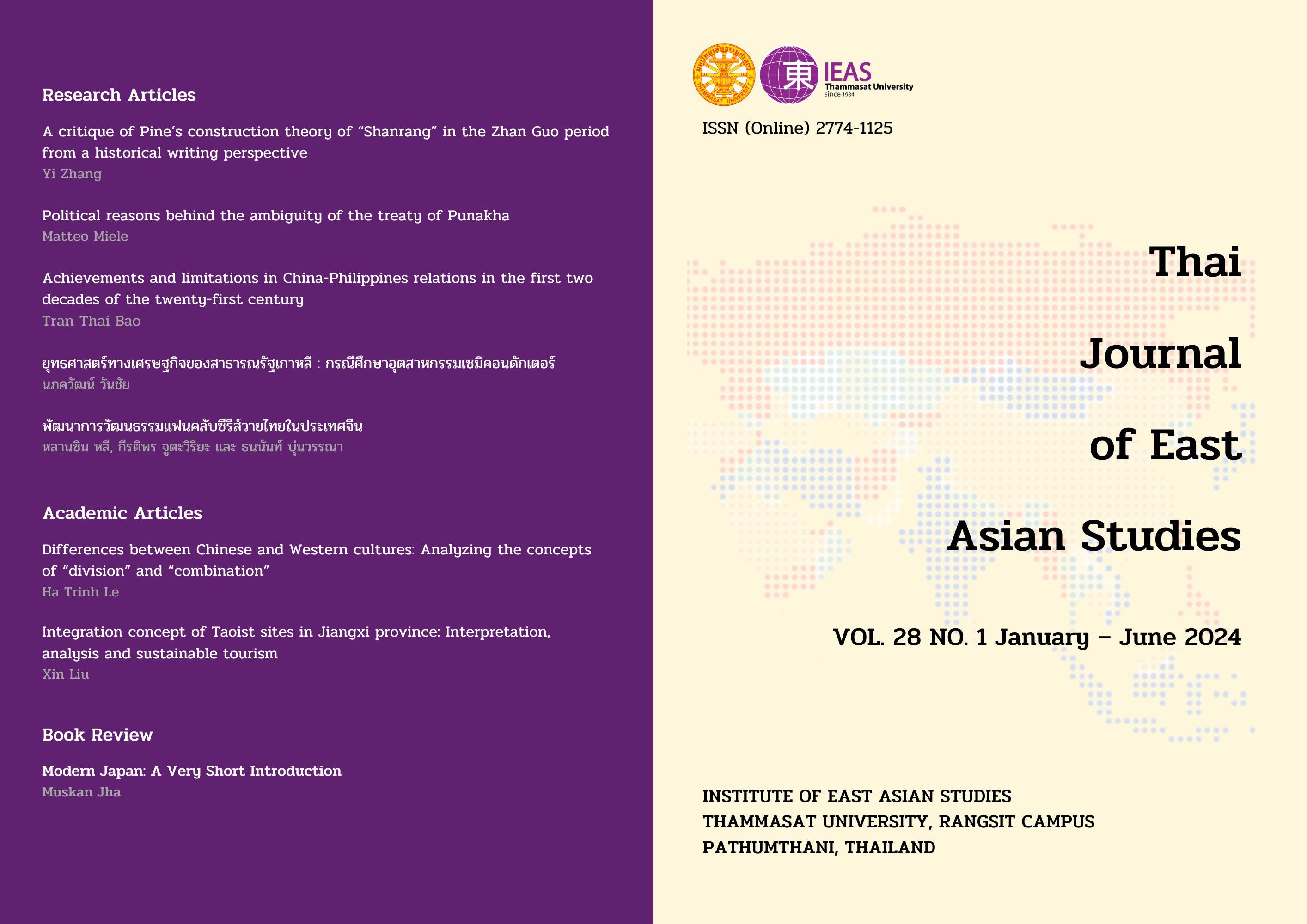A critique of Pine’s construction theory of “Shanrang” in the Zhan Guo period from a historical writing perspective
Keywords:
Yuri Pines, Shanrang system, Zhanguo period, History writingAbstract
Yuri Pines once proposed that shanrang (abdication) was a construction of the Zhanguo (Warring States) period, about 475 BCE to 221 BCE, and regarded shanrang as the historical invention of political thinkers of that era, especially equalitarians, rather than existing as a system in history. This article attempts to reexamine this viewpoint by existing literature in relevant fields (whether traditional Chinese books or the literature), and combining concepts, theories, and methods of history writing to comprehensively scrutinize the shanrang narrative in traditional Chinese history books, to discern whether and how shanrang should exist in history. After pinpointing shanrang’s place in history as an historical process, Pines’ theory was critically evaluated. The validation of this approach innovates in discussing ancient Chinese systems while revealing limitations in the shanrang construction theory during the Zhanguo period. These include an innately negative attitude about the existence of the shanrang system, and theoretical issues requiring attention that should inspire innovative thematic study of sinology.
Downloads
References
Allan, S. (2015). 世袭与禅让:古代中国的王朝更替传说 (Yu, J. Trans.). 商务印书馆. (Original work published 1981).
Лександр, С. М. (1987). Конфуцианская утопия в древности и средневековье. In Л. П. Делюсин & Л. Н. Борох (Eds.), Китайские социальные утопии (pp. 10-57). Наука.
Ankersmit, F. R. (1983). Narrative Logic: A Semantic Analysis of the Historian’s Language. Martinus Nijhoff.
Barthes, R. (1988). 现代西方学术文库 符号学原理 (Li, Y. Z. Trans.). 三联书店. (Original work published 1964).
Berque, J. (1972). Logique pluraliste du progrès. Diogène, 79, 3-26.
Certeau, de. M. (2012). 历史书写. 北京:中国人民大学出版社.
Chang, X. B. (2015). 后羿射日、除妖与尧之洪水的历史质地.史志学刊, 23(4), 61-67.
Chen, M. J. (2001). 尚书通论(外二种).河北教育出版社.
Crowell, S. G. (1998). Mixed Message: The Heterogeneity of Historical Discourse. History & Theory, 37(3), 220-244. https://doi.org/10.1111/0018-2656.00050
Fang, S. M. & Wang, X. L. (1981). 古本竹书纪年辑证. 上海古籍出版社.
Gu, J. G. (1982). 古史辨(第1册). 上海古籍出版社.
Graham, A. (1989). Disputers of the Tao: Philosophical Argument in Ancient China. Open Court.
Han, F. (2018). 韩非子. 漓江出版社.
Hao, Y. X. (1881). 郝氏遗书:山海经笺疏(卷十). 顺天府衙门.
Hsu, C. Y. (1963). 春秋戰國間的社會變動. 中央研究院歷史語言研究所集刊, 34(2), 559-587.
Huang, X. P. (2011). 禅让制与传统中国政权危机化解:基于传统“宪法”视角的考察. 中国政法大学出版社.
Krul, W. (1995). Huizinga’s definitie van de geschiedenis. In W. Krul (Ed.), De taak der cultuurgeschiedenis/Johan Huiziga (pp. 241-339). Historische Uitgeverij.
Lei, H. Z. (1934). 皇帝制度之成立. 清華學報 (自然科學版), 9(1), 853-871.
Lin, Z. P. (2016). 上博竹书《荣成氏》所见禹行征赋考.In History Department of East China Normal University (ed.). 华东师范大学出土文献与先秦史工作坊论文集. (pp.80-96). 华东师范大学历史系.
Lorenz, C. (1998). Can Histories be True? Narrativism, Positivism, and the “Metaphorical Turn”. History & Theory, 37(3), 309-329. https://doi.org/10.1111/0018-2656.00056
Lv, S. M. (2020). 先秦史. 江苏人民出版社.
Mencius. (2017). 孟子. 华夏出版社.
Munslow, A. (1947). Deconstructing History (2nd ed.). Routledge.
Ni, F. S. (2012). 书写与历史. In M. de. Certeau. 当代世界学术名著 历史书写 (Translated by Ni,F.S.) (pp. 1-23). 中国人民大学出版社. (Original work published 1975).
Pines, Y. (2004). Speechs and the Question of Authenticity in Ancient Chinese Historical Records. In Schmidt-Glintzer,H. et al (Ed.). Historical Truth, Historical Criticism, and Ideology:Chinese Historiography and Historical Culture from a New Comparative Perspective. (pp. 197-226). Brill. https://doi.org/10.1163/9789047406914_013
Pines, Y. (2005). Disputers of Abdication: Zhan Guo Egalitarianism and the Sovereign’s Power, T’oung Pao, 90(4-5), 243-300. https://doi.org/10.1163/156853205774910098
White, H. (1973). Metahistory: The Historical Imagination in Nineteenth-Century Europe. Johns Hopkins University Press.
Wang, Q. W. (2006). 从出土文献对战国禅让思想的思考In Cheng, J.Z. (Ed.). 陕西历史博物馆馆刊(13辑). (pp. 77-83). 三秦出版社.
Wang, X. Q. (1987). 庄子集解. 中华书局.
Xu, Z. S. (1958). 论尧舜禅让与父系家族私有制的发生和发展. 四川大学学报 (哲学社会科学版), 4(1), 115-128.
Xun, Z. (1922). 荀子(卷三). 景芬楼.
Yang, Y. J. (2005). “禅”、“让”释义及其在先秦、秦汉典籍中的运用. 井冈山师范学院学报(社会科学版), 26(2), 9-13.
Ye, S. X. (2016). 尧舜禅让:儒家政治神话的历史建构. 民族艺术, 32(2), 37-47.
Zhang, F. T. (2004). 中国帝王观念:社会普遍意识中的“尊君—罪君”文化范式. 中国人民大学出版社.
Zhang, Y. B. (2011). 安克斯密特论语言与崇高历史经验的关系. 史学理论研究 , 20(3), 19-22.
Downloads
Published
How to Cite
Issue
Section
License
Copyright (c) 2024 Thai Journal of East Asian Studies

This work is licensed under a Creative Commons Attribution-NonCommercial-NoDerivatives 4.0 International License.



